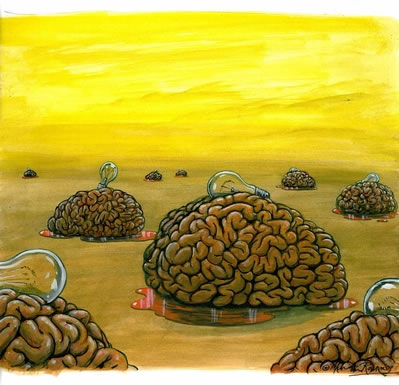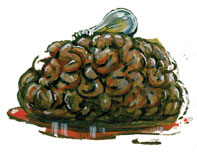Read the whole article.Neurotrash
Contemporary neuroscience is one of mankind’s greatest intellectual achievements. As a researcher for many years into new methods of rehabilitating people with neurological damage, in particular due to strokes, I have been thrilled by the promise of new technologies such as sophisticated brain scanning to help us to understand the processes of recovery and (more importantly) suggest treatments that would promote the kinds of reorganisation in the brain associated with return of function. In contrast, I am utterly dismayed by the claims made on behalf of neuroscience in areas outside those in which it has any kind of explanatory power; by the neuro-hype that is threatening to discredit its real achievements.
Hardly a day passes without yet another breathless declaration in the popular press about the relevance of neuroscientific findings to everyday life. The articles are usually accompanied by a picture of a brain scan in pixel-busting Technicolor and are frequently connected to references to new disciplines with the prefix “neuro-”. Neuro-jurisprudence, neuro-economics, neuro-aesthetics, neuro-theology are encroaching on what was previously the preserve of the humanities. Even philosophers – who should know better, being trained one hopes, in scepticism – have entered the field with the discipline of “Exp-phi” or experimental philosophy. Starry-eyed sages have embraced “neuro-ethics”, in which ethical principles are examined by using brain scans to determine people’s moral intuitions when they are asked to deliberate on the classic dilemmas. Benjamin Libet’s experiments on decisions to act and the work on mirror neurons (observed directly in monkeys but only inferred, and still contested, in humans) have been ludicrously over-interpreted to demonstrate respectively that our brains call the shots (and we do not have free will) and to point to a neural basis for empathy.
Art, that most distinctive of human activities, most remote, one would have thought, from our organic being, has been a particular focus of attention. The aficionados of “neuro-aesthetics” link the impact of different kinds of art the different areas of the brain that light up when we engage with them. The creation of art itself is a neurally mediated activity by which the artist unknown to himself behaves in such a way as to promote the replication of his genetic material. “Neuro-arthistory” explains the emergence of different theories of art by the influence of the environment on the plastic brain of the critic. Even the sponsorship of the arts is regarded as a manifestation of the reputation reflex by which, like the peacock whose useless tail advertises the health of his genes, the sponsor advertises the health of his business.
This might be regarded as harmless nonsense, were it not for the fact that it is increasingly being suggested (as for instance by Matthew Taylor in a recent issue of Prospect) that we should use the findings of neurosciences to guide policymakers. The return of political scientism, particularly of a biological variety, should strike a chill in the heart. The last century demonstrated how quickly social policies based in pseudoscience, which treated the individual person not as an independent centre of action and judgement but simply as a substrate to be shaped by appropriate technologies, led to catastrophe. But historical examples may not be persuasive because it will be argued that this time the intentions are better and consequently the results will be less disastrous. A better line of argument is to expose the groundlessness of the claim that observation of brain activity in certain experimental conditions can enable us to understand human beings to the point where neuroscience could usefully inform social policy. To do that, we need to examine the assumptions behind the hype.
The fundamental assumption is that we are our brains and this, I will argue presently, is not true. But this is not the only reason why neuroscience does not tell us what human beings “really” are: it does not even tell us how the brain works, how bits of the brain work, or (even if you accept the dubious assumption that human living could be parcelled up into a number of discrete functions) which bit of the brain is responsible for which function. The rationale for thinking of the kind – “This bit of the brain houses that bit of us...” – is mind-numbingly simplistic. In a typical experiment, individuals are exposed to different stimuli, or asked to imagine certain scenarios, and the change in brain activity is recorded. For example, a person may be asked to look at a photograph of, or think of, someone they love and then someone to whom they are relatively indifferent. The difference between the activation of the brain under the two circumstances is meant to show what is special about the emotion of love. On the basis of these and other experiments, the brain scientists Semir Zeki and Andreas Barthels [link to pdf] have concluded that love is due to activity “in the medial insula and the anterior cingulated cortex and, subcortically, in the caudate nucleus and the putamen, all bilaterally.”
Why is this fallacious?
Here is Matt Grist's response to this - Grist is director of the RSA’s social brain project.
Neuroscience can help tame the elephant
In the current issue of New Humanist the estimable Ray Tallis launches a well-rehearsed attack on simplistic neuroscientific determinism. It makes good copy but in criticising others, including us, for overstatement the good Professor makes the same error himself.
He also gets some things plain wrong. Tallis says the RSA has started a big project called the “Social Brain”, as has the British Academy. The RSA’s project can hardly be considered big, as it employs only one full-time researcher. The British Academy's project on the other hand is the result of an interdisciplinary collaboration between several UK universities.
The British Academy project is concerned with uncovering the origins of human language. As such it involves some neuroscience, some evolutionary anthropology, and some archaeology. It is a project that looks at language use – that is, it is concerned not only with the brains that generated the first human language, but the nexus of tools, practices and customs within which the possessors of such brains communicated. Professor Tallis’s accusation that this project reduces human culture, social interaction and language use to “quasi-animal societies” controlled by genes is unfair. Just because neuroscience is in the mix, doesn’t mean every explanation is reduced to it.
The RSA project takes a similar interdisciplinary approach. We have gotten together psychologists, sociologists, anthropologists and philosophers, along with neuroscientists. From the very start we understood that neuroscience was a necessary not a sufficient condition for understanding human behaviour. But we thought it was a level of understanding that should not be ignored.
Understanding a necessary condition of a phenomenon is still a worthwhile task, even if that understanding is limited. To make an analogy, if the other behavioural sciences understand the rest of the car, neuroscience understands the engine. One might drive the car perfectly well without understanding how the engine works, but it surely doesn’t hurt to know more about the engineering.
Tallis accuses Madeleine Bunting of thinking an automaton wrote a recent Guardian article, because she admitted she had come to doubt the idea of a completely autonomous self. This is silly. Accepting that automatic and unconscious brain processes contribute to conscious action is not the same as thinking one is an automaton.
The reason policy makers might be interested in brains and behaviour is that policy has to do (but not only to do) with aggregate level effects of individual actions. So if it can be shown that brains have certain shortcomings or potentialities not previously understood, then this is useful for informing policy direction. However, it is not clear that any policy yet has been informed by neuroscience. Even so-called “nudge” policies such as auto-enrollment in private pensions could have been devised from behavioural observations alone (observations attentive to the power of inertia in human decision-making). Part of the idea of our project is to have a conversation about what neuroscience does add to purely behavioural research.
Perhaps it adds nothing at all beyond what Sarah-Jayne Blakemore, speaking at the RSA, called, “the seductive allure of neuroscientific explanations”. Camilla Batmanghelidjh, after fourteen years experience of supporting neglected and abused children through her organisation the Kids Company, has come to believe vehemently that punishing and blaming such children is counterproductive. Such a punitive method is based on the mistake of thinking that the kids see before them an array of choices, one of them presenting itself as the morally correct one, yet which they choose to ignore. She argues that in fact what is needed is to get these kids into a position where they can see the full array of choices in the first place. This is done through structured activities that build-up the kids” capacity to see the world from the point of view of others, to gain control of their emotions, and to feel self-worth. The work Ms Batmanghelidjh has done has been highly successful. However, she has now embarked on research with neuroscientific partners so that she can present evidence of her success in terms of brain scans. We, as a society of empiricists, seem to need the neuroscientific level of explanation to convince us such a social policy is right. So the role of neuroscience in policy may simply sometimes be one of corroboration.
Read the whole response.



No comments:
Post a Comment